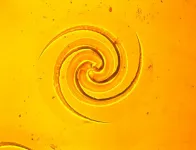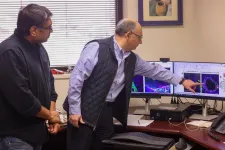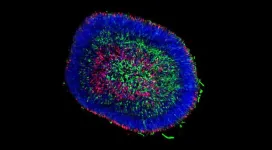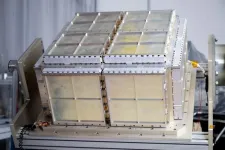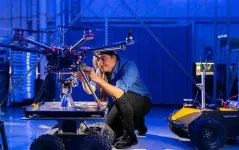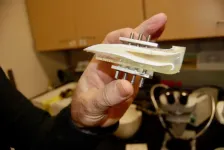(Press-News.org) Key takeaways
Curiosity about a mistake that left tiny dots on a germanium wafer with evaporated metal films led to the discovery of beautiful spiral patterns etched on the surface of the semiconductor by a chemical reaction.
Further experiments showed that the patterns arise from chemical reactions that are coupled to mechanical forces through the deformation of a catalyzing agent.
The new system is the first major advance in experimental methods to study chemical pattern formation since the 1950s. Studying these complex systems will help scientists understand other natural processes, from crack formation in materials to how stress influences biological growth.
UCLA doctoral student Yilin Wong noticed that some tiny dots had appeared on one of her samples, which had been accidentally left out overnight. The layered sample consisted of a germanium wafer topped with evaporated metal films in contact with a drop of water. On a whim, she looked at the dots under a microscope and couldn’t believe her eyes. Beautiful spiral patterns had been etched into the germanium surface by a chemical reaction.
Wong’s curiosity led her on a journey to discover what no one had seen before: Hundreds of near-identical spiral patterns spontaneously can form on a centimeter square germanium chip. What’s more, small changes in experiment parameters, such as the thickness of the metal film, generated different patterns, including Archimedean spirals, logarithmic spirals, lotus flower shapes, radially symmetric patterns and more.
The discovery, published in Physical Review Materials, occurred fortuitously when Wong made a small mistake while attempting to bind DNA to the metal film.
“I was trying to develop a measurement technique to categorize biomolecules on a surface through breaking and reforming of the chemical bonds,” Wong said. “Fixing DNA molecules on a solid substrate is pretty common. I guess nobody who made the same mistake I did happened to look under the microscope.”
To learn more about how the patterns formed, Wong and co-author Giovanni Zocchi, a UCLA physics professor, investigated a system that involved evaporating a 10-nanometer thick layer of chromium on the surface of a germanium wafer, followed by a 4-nanometer layer of gold. Next, the researchers placed a drop of mild etching solution onto the surface and dried it overnight, then washed and re-incubated the chip with the same etching solution in a wet chamber to prevent evaporation.
“The system basically forms an electrolytic capacitor,” Zocchi said.
Over the course of 24-48 hours, a chemical reaction catalyzed by the metal film etched remarkable patterns on the germanium surface. Investigation of the process revealed that the chromium and gold films were under stress and had delaminated from the germanium as the catalytic reaction proceeded. The resulting stress created wrinkles in the metal film that, under further catalysis, etched the amazing patterns the researchers had seen.
“The thickness of the metal layer, the initial state of mechanical stress of the sample, and the composition of the etching solution all play a role in determining the type of pattern that develops,” Zocchi said.
One of the most exciting findings in this study is that the patterns are not purely chemical but are influenced by residual stress in the metal film. The research suggests that the metal’s preexisting tension or compression determines the shapes that emerge. Thus, two processes, one chemical and one mechanical, worked together to yield the patterns.
This type of coupling, formed between catalysis-driven deformations of an interface and the underlying chemical reactions, is unusual in laboratory experiments but common in nature. Enzymes catalyze growth in nature, which deforms cells and tissue. It’s this mechanical instability that makes tissue grow into particular shapes, some of which resemble the ones seen in Wong’s experiments.
“In the biological world, this kind of coupling is actually ubiquitous,” Zocchi said. “We just don’t think of it in laboratory experiments because most laboratory experiments about pattern formation are done in liquids. That’s what makes this discovery so exciting. It gives us a non-living laboratory system in which to study this kind of coupling and its incredible pattern-forming ability.”
The study of pattern formation in chemical reactions began in 1951 when the Soviet chemist Boris Belousov accidentally discovered a chemical system that could spontaneously oscillate in time, which inaugurated the new fields of chemical pattern formation and nonequilibrium thermodynamics. At the same time and independently, the British mathematician Alan Turing discovered that chemical systems, later termed “reaction-diffusion systems,” could spontaneously form patterns in space, such as stripes or polka dots. The reaction-diffusion dynamics observed in Wong’s experiments mirrored the theoretical ones posited by Turing.
Although the field of complex systems in physics and pattern formation enjoyed a time in the spotlight during the 1980s and 90s, to this day, the experimental systems used to study chemical pattern formation in the laboratory are essentially variants of ones introduced in the 1950s. The Wong-Zocchi system represents a major advance in the experimental study of chemical pattern formation.
END
How chemistry and force etch mysterious spiral patterns on solid surfaces
Hundreds of regular patterns spontaneously form on a small germanium chip
2025-03-13
ELSE PRESS RELEASES FROM THIS DATE:
Unraveling the mysteries of polycystic kidney disease
2025-03-13
OKLAHOMA CITY – Polycystic kidney disease (PKD), a family of genetic disorders that causes clusters of cysts to form on the kidney, is among the most common genetic disorders, affecting some 500,000 people in the United States. Roughly one in every 1,000 people will develop some form of cystic kidney disease during their lifetime, and nearly 40,000 Oklahomans have a chronic kidney disease, according to the Oklahoma Health Care Authority.
For many patients, dialysis – a time-consuming and costly procedure – is one of few treatment options. A 2021 study ...
Mother’s high-fat diet can cause liver stress in fetus, study shows
2025-03-13
OKLAHOMA CITY – When mothers eat a diet high in fat and sugars, their unborn babies can develop liver stress that continues into early life. A new study published in the journal Liver International sheds light on changes to the fetus’s bile acid, which affects how liver disease develops and progresses.
Bile acids typically help with digestion and absorb dietary fats in the small intestine, but when they reach excessive levels, they become toxic and can damage the liver. While the mother can detoxify the acids, the fetus lacks that ability. Bile acids may re-circulate to the mother for detoxification, but if they don’t, they build ...
Weighing in on a Mars water debate
2025-03-13
More than 3 billion years ago, Mars intermittently had liquid water on its surface. After the planet lost much of its atmosphere, however, surface water could no longer persist. The fate of Mars’ water—whether it was buried as ice, confined in deep aquifers, incorporated into minerals or dissipated into space—remains an area of ongoing research, one of particular interest to LASP Senior Research Scientist Bruce Jakosky, former principal investigator of the Mars Atmosphere and Volatile EvolutioN (MAVEN) mission.
Last week, in a letter to the editor ...
Researchers ‘seq’ and find a way to make pig retinal cells to advance eye treatments
2025-03-13
MADISON — Inside the human eye, the retina is made up of several types of cells, including the light-sensing photoreceptors that initiate the cascade of events that lead to vision. Damage to the photoreceptors, either through degenerative disease or injury, leads to permanent vision impairment or blindness.
David Gamm, director of UW–Madison’s McPherson Eye Research Institute and professor of ophthalmology and visual sciences, says that stem cell replacement therapy using lab-grown photoreceptors ...
Re-purposed FDA-approved drug could help treat high-grade glioma
2025-03-13
High-grade glioma, an aggressive form of pediatric and adult brain cancer, is challenging to treat given the tumor location, incidence of recurrence and difficulty for drugs to cross the blood-brain barrier.
Researchers from the University of Michigan, Dana Farber Cancer Institute and the Medical University of Vienna established a collaborative team to uncover a potential new avenue to address this disease.
A study, published in Cancer Cell, shows that high-grade glioma tumor cells harboring DNA alterations in the gene PDGFRA responded to the drug avapritinib, which is already approved by the United States Food and Drug Administration to treat gastrointestinal ...
Understanding gamma rays in our universe through StarBurst
2025-03-13
WASHINGTON, D.C. — The U.S. Naval Research Laboratory (NRL), in partnership with NASA’s Marshall Space Flight Center (MSFC), has developed StarBurst, a small satellite (SmallSat) instrument for NASA's StarBurst Multimessenger Pioneer mission, which will detect the emission of short gamma-ray bursts (GRBs), a key electromagnetic (EM) signature that will contribute to the understanding of neutron star (NS) mergers.
NRL transferred the instrument to NASA on March 4 for the next phase, environmental ...
Study highlights noninvasive hearing aid
2025-03-13
WINSTON-SALEM, N.C. – March 13, 2025 – A study from researchers at Wake Forest University School of Medicine highlights a new approach in addressing conductive hearing loss. A team of scientists, led by Mohammad J. Moghimi, Ph.D., assistant professor of biomedical engineering, designed a new type of hearing aid that not only improves hearing but also offers a safe, non-invasive alternative to implantable devices and corrective surgeries.
The study recently published in Communications Engineering, a Nature Portfolio journal.
Conductive ...
NASA taps UTA to shape future of autonomous aviation
2025-03-13
Envision a world where unmanned aircraft deliver goods to your front door and transport passengers in flying taxis, cargo planes cross continents carrying vital trade goods, and fighter jets patrol battle zones—all without a human pilot at the controls.
Those scenarios might seem a bit far-fetched now, but researchers are working diligently to develop these aircraft and ensure they operate safely. That’s why NASA has awarded a $1 million grant through its University Leadership Initiative (ULI) to a team from The University of Texas at Arlington Research ...
Mutations disrupt touch-based learning, study finds
2025-03-13
You may scarcely notice it, but much of what you do every day requires your brain to engage in perceptual learning. To safely cross an intersection or quickly retrieve something from your bag, you depend upon your brain to first assign meaning to sensory input from your eyes or fingertips.
Usually, it’s effortless.
Research from The Herbert Wertheim UF Scripps Institute for Biomedical Innovation & Technology shows a gene called Syngap1 enables touch-based perception, while certain mutations can lead to mixed signals. The research was made possible through grants from the National Institute of Mental Health and the National Institute ...
Misha lived in zoos, but the elephant’s tooth enamel helps reconstruct wildlife migrations
2025-03-13
Teeth recovered from a beloved zoo elephant that died in 2008 are helping University of Utah geologists develop a method for tracking the movements of large herbivores across landscapes, even for animals now extinct, such as mastodons and mammoths.
Outlined in recently published findings, the technique analyzes isotope ratios of the element strontium (Sr), which accumulates in tooth enamel. For large plant-eating land mammals, the relative abundance of two strontium isotopes in teeth and tusks ...
LAST 30 PRESS RELEASES:
This new understanding of T cell receptors may improve cancer immunotherapies
A new fossil face sheds light on early migrations of ancient human ancestor
A new immunotherapy approach could work for many types of cancer
A new way to diagnose deadly lung infections and save lives
40 percent of MRI signals do not correspond to actual brain activity
How brain-inspired algorithms could drive down AI energy costs
Gum disease may be linked to plaque buildup in arteries, higher risk of major CVD events
Contrails are a major driver of aviation’s climate impact
Structure of dopamine-releasing neurons relates to the type of circuits they form for smell-processing
Reducing social isolation protects the brain in later life
Keeping the heart healthy increases longevity even after cancer
Young adults commonly mix cannabis with nicotine and tobacco
Comprehensive review illuminates tau protein's dual nature in brain health, disease, and emerging psychiatric connections
Book prepares K-12 leaders for the next public health crisis
Storms in the Southern Ocean mitigates global warming
Seals on the move: Research reveals key data for offshore development and international ecology
Sports injuries sustained during your period might be more severe
World's first successful 2 Tbit/s free-space optical communication using small optical terminals mountable on satellites and HAPS
Can intimate relationships affect your heart? New study says ‘yes’
Scalable and healable gradient textiles for multi‑scenario radiative cooling via bicomponent blow spinning
Research shows informed traders never let a good climate crisis go to waste
Intelligent XGBoost framework enhances asphalt pavement skid resistance assessment
Dual-function biomaterials for postoperative osteosarcoma: Tumor suppression and bone regeneration
New framework reveals where transport emissions concentrate in Singapore
NTP-enhanced lattice oxygen activation in Ce-Co catalysts for low-temperature soot combustion
Synergistic interface engineering in Cu-Zn-Ce catalysts for efficient CO2 hydrogenation to methanol
COVID-19 leaves a lasting mark on the human brain
Scientists use ultrasound to soften and treat cancer tumors without damaging healthy tissue
Community swimming program for Black youth boosts skills, sense of belonging, study finds
Specific depressive symptoms in midlife linked to increased dementia risk
[Press-News.org] How chemistry and force etch mysterious spiral patterns on solid surfacesHundreds of regular patterns spontaneously form on a small germanium chip
